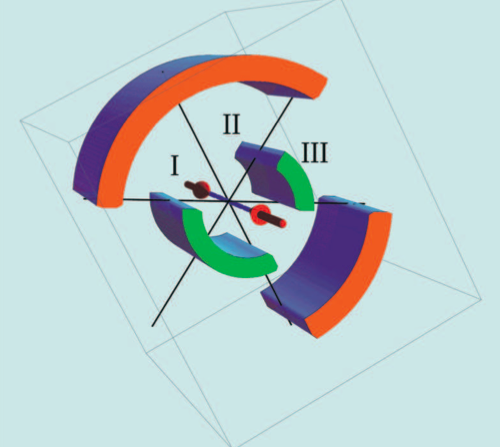A conclusive test for ‘spooky action at distance’
January 19, 2012

Sketch of a possible setup for testing the Bell inequality. The two beams collide in the origin and produce two neutral kaons propagating in opposite directions. Regions I,II,III cover measurements for different time choices (≡ distances). For any real experimental situation (e.g., pairs are not equally distributed in 4π) the geometry can be accordingly adapted. (credit: Hiesmayr B. C., et al.)
University of Vienna researchers have proposed the first conclusive experimental test of “Bell’s theorem” (“Bell’s inequality”) — that measuring a particle can instantly influence another quantum-entangled particle arbitrarily far away.
The researchers say they have succeeded in devising a new “Bell test” (of this theorem), taking into account the decay property of high-energy particles systems, called kaon-antikaon systems.
This procedure ensures that the test is conclusive — a goal that has never before been achieved — and simultaneously guarantees its experimental testability. Experimental testing requires equipment such as the KLOE detector at the accelerator facility DAPHNE in Italy.
Revealing “spooky action at distance” (Albert Einstein’s phrase) for kaon-antikaon pairs has fundamental implications for our understanding of such particles’ correlations and could ultimately allow us to determine whether symmetries in particle physics and manifestations of particles correlations are linked.
Ref.: Hiesmayr B. C. et al., Revealing Bell’s Nonlocality for Unstable Systems in High Energy Physics, European Physical Journal C, 2011 [DOI: 10.1140/epjc/s10052-012-1856-X]
Ref.: Hiesmayr B. C. et al., Revealing Bell’s Nonlocality for Unstable Systems in High Energy Physics, arxiv.org/abs/1111.4797